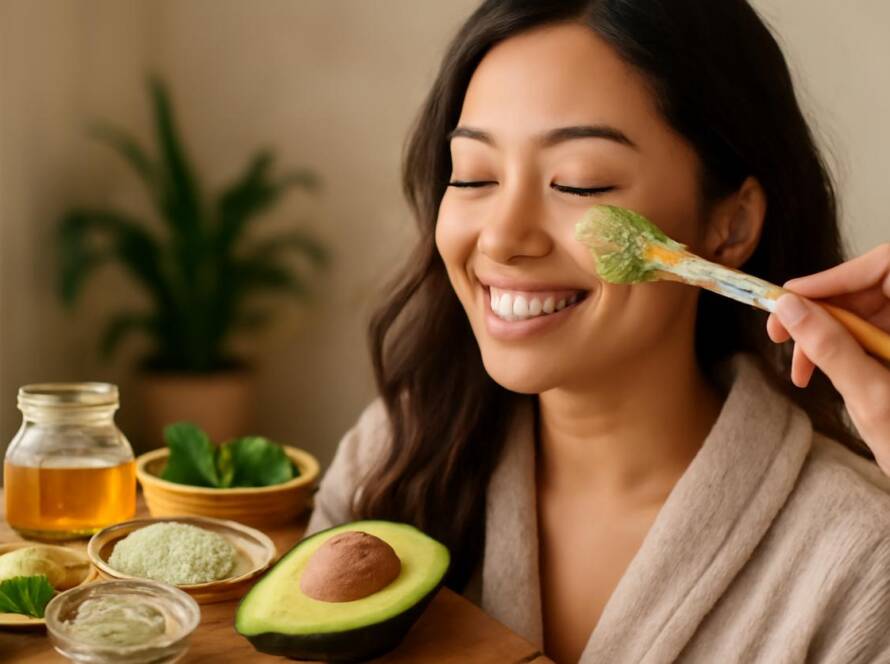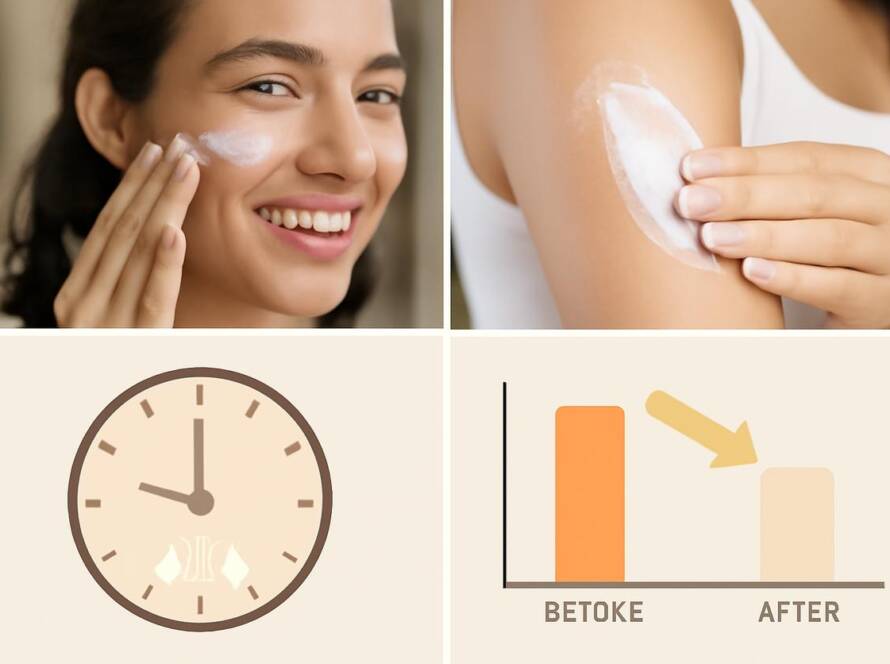What does ‘radiant skin’ really mean?
When we talk about achieving glowing skin, what are we truly picturing? It’s more than just a temporary shine or a lack of blemishes. True radiance is a reflection of overall skin health. It’s characterized by a smooth texture, an even and consistent tone, and a high level of hydration that makes the skin appear plump and well-rested. Healthy skin reflects light uniformly, which is what we perceive as a ‘glow’. This is in contrast to dull skin, which often has a buildup of dead cells that scatter light unevenly, making the complexion look flat and tired. So, the journey to glowing skin is fundamentally a journey toward healthier, more resilient skin.
Core habits that build skin luminosity
Before diving into specific products or complex routines, it’s crucial to master the fundamentals. Think of these core habits as the foundation upon which your entire skincare strategy is built. Without them, even the most advanced ingredients will fall short. Consistent daily practices are what create lasting, visible results and pave the way for genuinely glowing skin.
Hydration and barrier support explained
Your skin’s outermost layer is called the skin barrier (or stratum corneum). Imagine it as a brick wall: the skin cells are the bricks, and lipids (fats) are the mortar holding them together. A healthy barrier keeps moisture locked in and protects you from environmental aggressors like pollution and bacteria. When this barrier is compromised, skin becomes dry, irritated, and dull.
Supporting your skin barrier involves two key actions:
- Internal Hydration: Drinking an adequate amount of water throughout the day is fundamental. Dehydration can make your skin look sallow and emphasize fine lines.
- Topical Support: Using moisturizers with ingredients like ceramides, hyaluronic acid, and glycerin helps repair and reinforce the ‘mortar’ of your skin barrier, preventing water loss and keeping it supple.
Sun protection without complexity
If there is one non-negotiable step for achieving and maintaining glowing skin, it is daily sun protection. Sun exposure is the primary cause of premature aging, including fine lines, dark spots (hyperpigmentation), and a breakdown of collagen, which leads to loss of firmness. This damage directly counteracts your efforts to achieve a luminous complexion.
Keeping it simple is key to consistency:
- Choose a broad-spectrum sunscreen with an SPF of 30 or higher. ‘Broad-spectrum’ means it protects against both UVA (aging) and UVB (burning) rays.
- Apply it every single morning as the final step of your skincare routine, regardless of the weather or whether you plan to be indoors. UV rays can penetrate clouds and windows.
- Reapply every two hours if you are outdoors, sweating, or swimming.
Ingredients worth seeking and those to skip
Navigating the world of skincare ingredients can be overwhelming. To simplify, focus on a few proven powerhouses that support skin health and brightness. It’s equally important to know what to avoid, as harsh ingredients can strip the skin and undermine your progress. As of 2025 and beyond, the focus is on supporting the skin, not punishing it.
| Ingredients to Seek | What They Do for Glowing Skin |
|---|---|
| Vitamin C | A potent antioxidant that brightens the skin, fades dark spots, and protects against environmental damage. |
| Hyaluronic Acid | A humectant that draws moisture into the skin, making it look plump, hydrated, and dewy. |
| Niacinamide (Vitamin B3) | Improves skin barrier function, reduces redness, minimizes the appearance of pores, and evens out skin tone. |
| Alpha Hydroxy Acids (AHAs) | Acids like glycolic and lactic acid gently exfoliate the skin’s surface to remove dead cells, revealing brighter skin underneath. Use with caution 1-3 times per week. |
On the other hand, be cautious with ingredients that can compromise your skin barrier:
- Harsh physical scrubs: Scrubs with large, jagged particles (like crushed pits or shells) can create micro-tears in the skin, leading to irritation.
- High concentrations of denatured alcohol: Often found in toners, it can be excessively drying and strip the skin of its natural lipids.
- Unnecessary fragrance: Both synthetic and natural fragrances can be common sensitizers for many people, causing redness and irritation.
Pantry friendly foods and topical remedies
The path to glowing skin is holistic; it starts from within. The nutrients you consume play a direct role in your skin’s structure, repair, and overall appearance. You can supplement a great skincare routine with a diet rich in skin-loving foods and simple, safe topical treatments made from ingredients you already have at home.
Focus on incorporating these foods into your diet:
- Healthy Fats: Avocados, nuts, seeds, and olive oil provide essential fatty acids that help keep the skin barrier strong and hydrated.
- Antioxidant-Rich Fruits and Vegetables: Berries, leafy greens, and colorful vegetables are packed with vitamins and antioxidants that fight free radical damage.
- Vitamin C Sources: Citrus fruits, bell peppers, and broccoli support collagen production, which is key for skin firmness.
For a topical boost, consider a simple honey mask. Honey has natural antibacterial and humectant properties. Apply a thin layer of raw honey to clean, damp skin, leave it on for 10-15 minutes, and rinse. Always patch-test any new ingredient on a small area of skin first.
Vitamins and supplements evidence summary
While a balanced diet is the best source of nutrients, some supplements are studied for their skin benefits. According to research, vitamins like C and E act as powerful antioxidants, while minerals like zinc can help with inflammation. Collagen supplements have also gained popularity for their potential to improve skin elasticity and hydration. However, the supplement industry is not tightly regulated. It’s essential to consult with a healthcare provider before starting any new supplement to ensure it’s appropriate for you. For more information, you can review data on vitamins for healthy skin.
Weekly at home rituals and safety tips
Incorporating a weekly ritual can boost your daily efforts and provide a moment of self-care. The key is to be gentle and consistent. Once or twice a week, consider using a chemical exfoliant with AHAs to dissolve dead skin cells. This is often gentler and more effective than a physical scrub. Follow up with a hydrating mask containing ingredients like hyaluronic acid or aloe vera to replenish moisture. Always listen to your skin; if you experience any stinging or redness, scale back. Safety is paramount, so never introduce multiple new powerful products at once.
Simple science backed morning routine (step by step)
A morning routine should be focused on protection. You’re preparing your skin to face the day’s environmental stressors. Keep it simple and effective for a consistent path to glowing skin.
- Cleanse: Wash your face with a gentle, hydrating cleanser. You only need to remove the sweat and skincare from the night before, so there’s no need for anything harsh.
- Treat (Antioxidant): Apply a Vitamin C serum to clean, dry skin. This helps protect against free radical damage from UV rays and pollution throughout the day.
- Hydrate: Use a moisturizer suited to your skin type to lock in moisture and support your skin barrier.
- Protect: Finish with a generous layer of broad-spectrum sunscreen with at least SPF 30. This is the most critical step to prevent future damage.
Evening repair routine with product alternatives
Your evening routine is all about repair and replenishment. While you sleep, your skin goes into a regenerative mode, making it the perfect time to use targeted treatment products.
- Double Cleanse: If you wear makeup or sunscreen, start with an oil-based cleanser to break it down, followed by your regular gentle cleanser to wash everything away.
- Treat: This is the time for active ingredients. On alternating nights, you could use a serum with niacinamide to support your barrier or a gentle chemical exfoliant. If you are new to actives, start slowly (1-2 times a week) and build up as your skin tolerates it.
- Moisturize: Apply a good moisturizer to support your skin’s repair process overnight. You can use a slightly richer cream than in the morning if your skin feels dry.
Four week sample plan to notice change
True change takes time and consistency. This four-week plan is designed to introduce habits and products slowly to avoid irritation and allow you to see what works for your skin. The goal is building a sustainable routine for long-term glowing skin.
| Week | Focus | Key Actions |
|---|---|---|
| Week 1 | Establish the Foundation | Focus solely on a gentle cleanser, a simple moisturizer, and a daily SPF 30+ sunscreen. Do this every morning and night (minus the SPF at night). The goal is consistency. |
| Week 2 | Introduce Protection | Continue with your foundation routine. Add one antioxidant serum (like Vitamin C) in the morning after cleansing but before moisturizing. |
| Week 3 | Boost Renewal | Continue your established routine. Introduce a gentle chemical exfoliant (like a lactic acid toner) just one or two nights per week after cleansing. Observe how your skin responds. |
| Week 4 | Hydrate and Observe | Maintain your full routine. Add a hydrating mask one night a week (on a non-exfoliating night). Take note of improvements in your skin’s texture, tone, and overall glow. |
Common myths and quick fact checks
- Myth: You can shrink your pores.
Fact: Pore size is largely determined by genetics. However, you can make them appear smaller by keeping them clean and free of debris with regular, gentle exfoliation.
- Myth: If you have oily skin, you should skip moisturizer.
Fact: Oily skin still needs hydration. Dehydrating it can actually cause it to produce even more oil to compensate. Opt for a lightweight, oil-free moisturizer.
- Myth: Drinking more water will cure dry skin.
Fact: While internal hydration is crucial for overall health, topical moisturizers are necessary to prevent water from evaporating from the skin’s surface and to repair the skin barrier.
When to consult a skincare professional
While a consistent routine can significantly improve your skin’s appearance, some conditions require professional guidance. If you are struggling with persistent acne, rosacea, severe hyperpigmentation, or have any concerns about new or changing moles, it’s best to consult a board-certified dermatologist. They can provide an accurate diagnosis and create a prescription-strength treatment plan tailored to your needs. For help finding a qualified expert, a great resource is the American Academy of Dermatology, which offers professional skin care advice and directories.
Further reading and references
For those interested in delving deeper into the science of skin health, these resources offer evidence-based information from trusted sources:
- Best foods for healthy skin – A scientific review of diet and dermatology.
- Natural skin care remedies – An academic look into the role of natural ingredients in cosmetology.
- Skin rejuvenation – An overview of techniques and the science behind skin aging and renewal.



